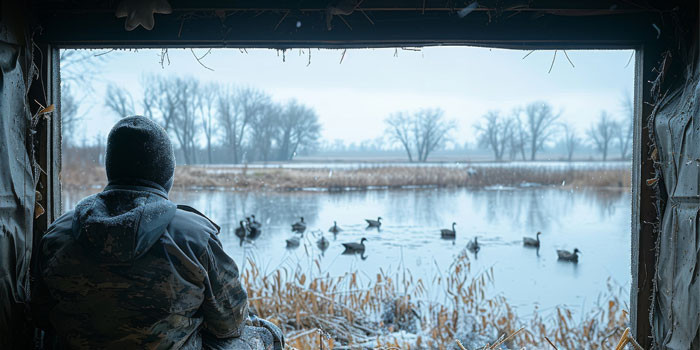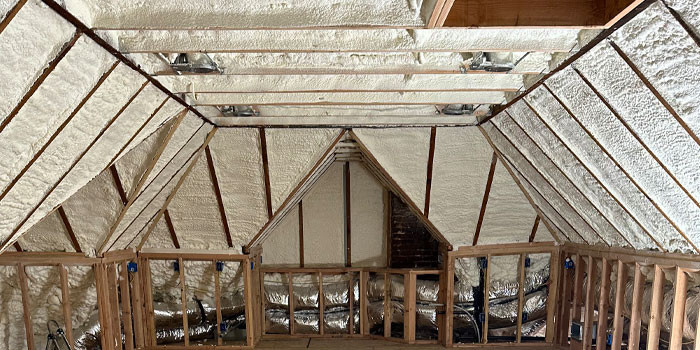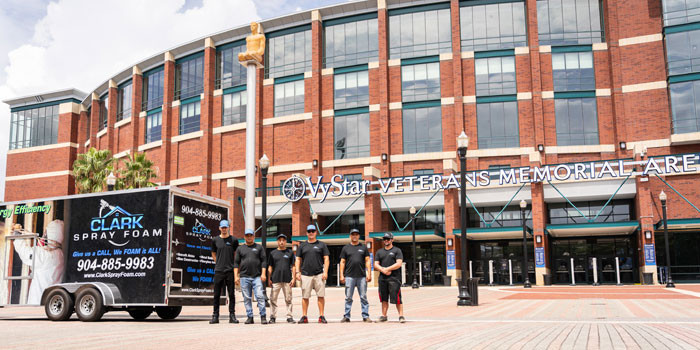Worth Barking About


Spray Foam Magazine – Winter Issue 2024 – Situated within a section of the Southern River suburb in Perth, Western Australia is a block of animal-centric establishments such as dog boarding kennels and catteries. The zone’s proprietors are all business-minded animal lovers who want to deliver the best experience to their clients of all species. Whenever a project brings a net positive for the animals in their care, word travels fast around the community.
Such was the case for Spray Foam Australia (SFA), who saw a single job for one kennel client grow into four jobs for two kennel clients. The clients, Hi-Five Boarding Kennels and Abbeyvale Lodge Boarding Kennels, both wanted to install spray foam insulation to make the kennels more comfortable for the dogs and facility staff.
Spray Foam Australia was founded in Perth in 2014 and has since expanded into a national business, with teams operating in Perth, New South Wales, Victoria, and Queensland. Their business relationship with the two kennels began just in time for sweltering summer temperatures to peak. Ali Chen of Hi-Five Boarding contacted Jordan Barbas, SFA’s Business Development Manager to find out if spray foam could reduce the temperature inside the kennels by insulating against the heat outside. He expressed interest but wanted some additional reassurance that spray foam was in fact the best choice for his kennels.
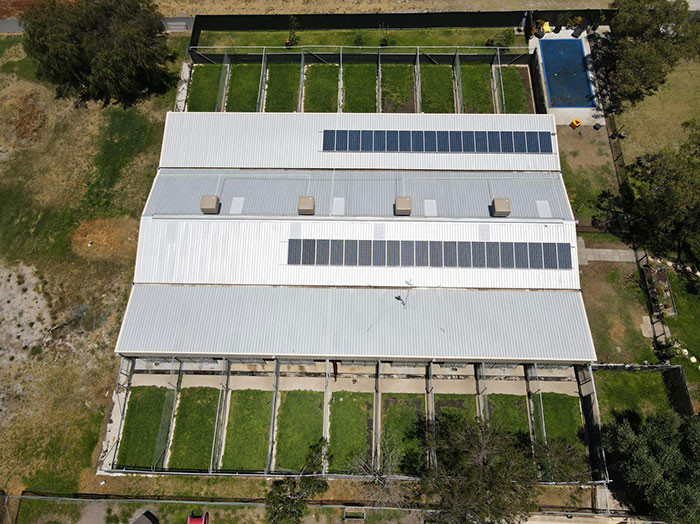
An aerial shot of Hi-Five Boarding Kennels in Southern River, Western Australia.
“He wanted to cool down the space for his dogs,” Barbas recalled. “We ended up doing a trial installation on his patio where his personal pets reside. That resulted in us securing the work at the dog kennels.”
After seeing closed-cell spray foam work its cooling magic on his home patio, Chen hired SFA. They proposed Pacific Urethanes closed-cell foam to each boarding facility’s roof deck and walls to reduce radiant heat in the kennels and help the kennels save on cooling costs. The areas totalled around 750 m2. (about 8,100 sq. ft.).
Chen runs a premium operation at Hi-Five, with about 60 indoor-outdoor kennels plus a swimming pool for the dogs to enjoy when it gets too hot. The kennel walls are built out of brick, and the roof deck is made of corrugated steel, an optimal substrate for the foam to adhere to. Both sides of the kennel remain open, with metal fencing instead of a wall so that the dogs can each have access to an outdoor lawn. The kennel’s open layout poses a challenge for temperature regulation, but insulating the interior can still make a difference even though the building is not fully enclosed. The SFA team planned to install 48mm (approximately two inches) of Pacific Urethane’s Medium Density 334 closed-cell foam to achieve the desired insulation value.
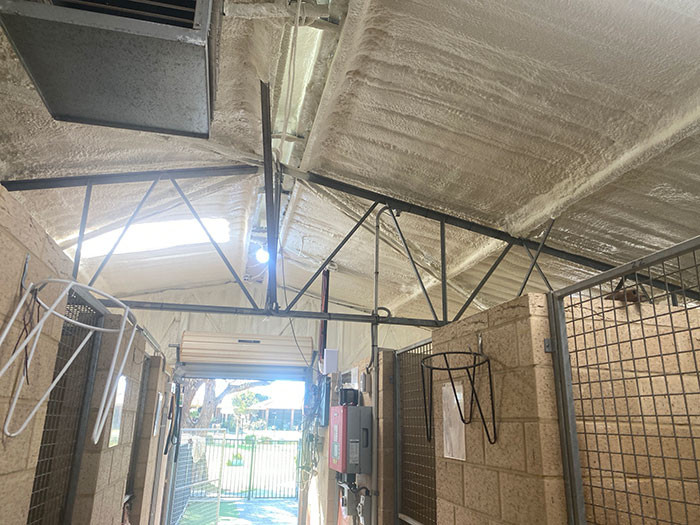
A layer of closed-cell spray foam applied to the roof deck at the Hi-Five Boarding Kennels.
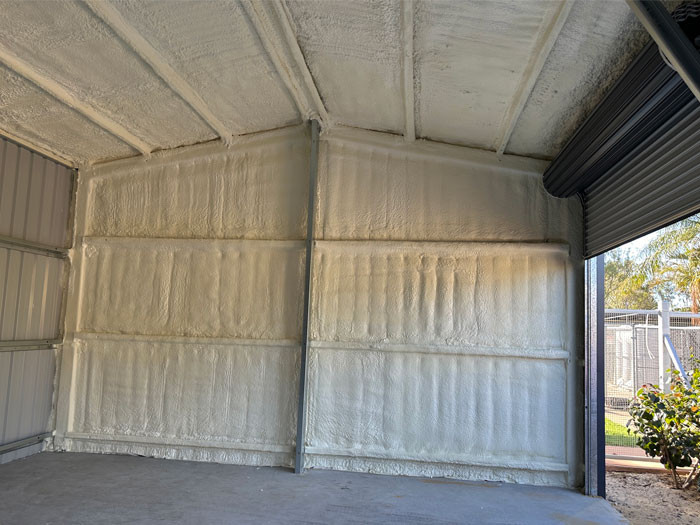
An area of the Hi-Five Boarding Kennel midway through installing foam to the roof deck and walls.
Barbas knew that closed-cell foam would help reduce radiant heat inside the kennel and seal any cracks or gaps in the walls and roof deck. Pacific Urethanes’ products are frequently in SFA’s rotation because it’s a versatile foam that can fit most client’s needs.
Four SFA technicians visited Hi-Five in February of 2024. They’d be installing the foam over the course of two weekends, or four days total. Working at the kennels, especially one as large and full of dogs as Hi-Five’s, would require a little more communication and coordination than other job sites. For one thing, they couldn’t start spraying until the dogs were cleared from the area and moved elsewhere. The limited availability of kennels during spraying meant they had to spray strategically while the facility rotated dogs in and out of open kennels. Though the dogs couldn’t remain in the area during the foam install, they were perfectly safe to return after it set.
While they worked, temperatures hovered around 40 degrees Celsius – over a hundred degrees Fahrenheit, but the technicians didn’t let the heat slow them down. They began the site preparation process by taping plastic drop sheets to the ground for protection. A dog that doesn’t know any better could mistake dried spray foam for a tasty treat or a fun chew toy. The drop sheets would catch any drips or overspray from going where it’s not supposed to go.
“The prep work is the most important part of the process.” Barbas described. “Without good prep, it can open you up to a lot of nuisances. A lot of the time, our boys spend more time prepping than they do spraying.”
While one tech taped down protective plastic, others situated the scaffolding and ladders, while yet another fired up the equipment. To efficiently spray all 60 of Hi-Five’s kennels, SFA opted to use two Graco E-30s with Graco Fusion PC spray guns to apply the foam.
The sprayers wore Sundstrom SR 200 full-face masks along with coveralls and protective gloves. They applied about two inches of Pacific Urethanes Medium Density 334 closed-cell foam to the kennel’s brick walls and pitched steel roof deck. Because one side of the roof deck was not attached to a wall, they also foamed the small overhanging area known as an upstand. After spraying, they simply left the foam to dry and let the quality speak for itself. The foam wouldn’t get exposed to direct sunlight, so UV coatings and paint were not necessary. Plus, the install looked nice enough as-is.
SFA finished the install at Hi-Five, but it wasn’t the last time they’d visit the Southern River suburb. Soon enough, the owners of Abbeyvale Lodge Boarding Kennels reached out. Just like with Chen at Hi-Five, SFA was contracted to spray more kennels, but first, the Abbeyvale owner also wanted to trial a smaller section prior to spraying the main kennels. SFA sprayed a 40-m2 (approximately 430-sq.-ft.) holding kennel for Abbeyvale as part of a trial. This successful installation resulted in the client proceeding with spraying the main kennel at 95 m2 (about 1,023 sq. ft.), plus an additional personal shed a few months later.
Both kennel jobs were similar in many ways, but the Abbeyvale Lodge required a few extra steps. The facility had some existing fiberglass insulation that was decades old and harboring rodents. The SFA team assisted with removing the old insulation and cleaning the substrate prior to installing the closed-cell foam. The techs stood on scaffolding and used Stanley knives to cut away the old foam and dispose of it in trash bags. It was tiring work, but they managed to finish the Abbeyvale job in about a day and a half.
Adding a layer of closed-cell foam around the inside should help Hi-Five Boarding and Abbeyvale Lodge save money on cooling efforts for the dogs. With the foam serving as a passive insulator against radiant heat, the kennels can save on energy for fans and air-conditioning, and use less water on misting fans, sprinklers, and refilling pools.
Spray Foam Australia’s trip into the doghouse yielded cool results, with one trial job yielding three major projects. Installing closed-cell foam at two dog boarding kennels made a big difference in the comfort of the four-legged clientele, showing that even unenclosed buildings can benefit from foam insulation.
Disqus website name not provided.



